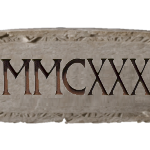The Roman numeral “MMXXXIX” represents the number 2,039 in standard Arabic numerals. Here’s the breakdown of “MMXXXIX”:
“MM” represents 2,000 because “M” stands for 1,000, and there are two “M”s, so 2 * 1,000 = 2,000.
“XXX” represents 30 because “X” stands for 10, and there are three “X”s, so 3 * 10 = 30.
“IX” represents 9 because “I” stands for 1, and “X” stands for 10, but “IX” is a subtraction of 1 from 10, resulting in 9.
Now, you add these together: 2,000 + 30 + 9 = 2,039. So, “MMXXXIX” is equal to 2,039 in Arabic numerals.
Here are some related concepts or operations you can explore with this number:
Addition: You can add “MMXXXIX” to other Roman numerals or Arabic numerals. For example, “MMXXXIX” + “X” (10) = “MMXLIX” (2,049).
Subtraction: You can subtract Roman numerals or Arabic numerals from “MMXXXIX.” For example, “MMXXXIX” – “XX” (20) = “MMLXIX” (2,019).
Multiplication: You can multiply “MMXXXIX” by another Roman numeral or Arabic numeral. For instance, “MMXXXIX” * “III” (3) = “VI” (6,117).
Division: You can divide “MMXXXIX” by another Roman numeral or Arabic numeral. For example, “MMXXXIX” ÷ “V” (5) = “CDVII” (407.8).
Year: “MMXXXIX” could represent a year in Roman numerals. For instance, it corresponds to the year 1039 AD.
In the year 1039 AD, several historical events took place around the world. Here are a few notable events from that year:
- Death of Canute the Great: On November 12, 1035, Canute the Great, also known as Cnut the Great, the King of England, Denmark, Norway, and parts of what is now Sweden, passed away. In the years following his death, there were significant political changes in these regions.
- Great Seljuk Empire: The Great Seljuk Empire, a medieval Turko-Persian empire, continued its expansion. During this period, the empire under Sultan Tughril Beg was consolidating its power in the Middle East, including parts of Iran and Iraq.
- Norman Conquests in Southern Italy: The Normans, led by Robert Guiscard, continued their campaigns in southern Italy and Sicily. They captured the city of Bari in 1071, further establishing their presence in the region.
- Chinese Astronomy: In the Song Dynasty of China, the prominent scientist Shen Kuo (1031–1095) published his famous work, the “Dream Pool Essays” (Mengxi Bitan). This book covered various scientific topics, including astronomy, mathematics, and geology.
- Birth of Anselm of Canterbury: Anselm of Canterbury, a prominent philosopher and theologian, was born in 1033 or 1034 in Aosta, Italy. He later became the Archbishop of Canterbury and made significant contributions to the development of Scholasticism.
These are just a few examples of historical events from the year 1039 AD. It was a time of political changes, intellectual pursuits, and ongoing military campaigns in various parts of the world.

